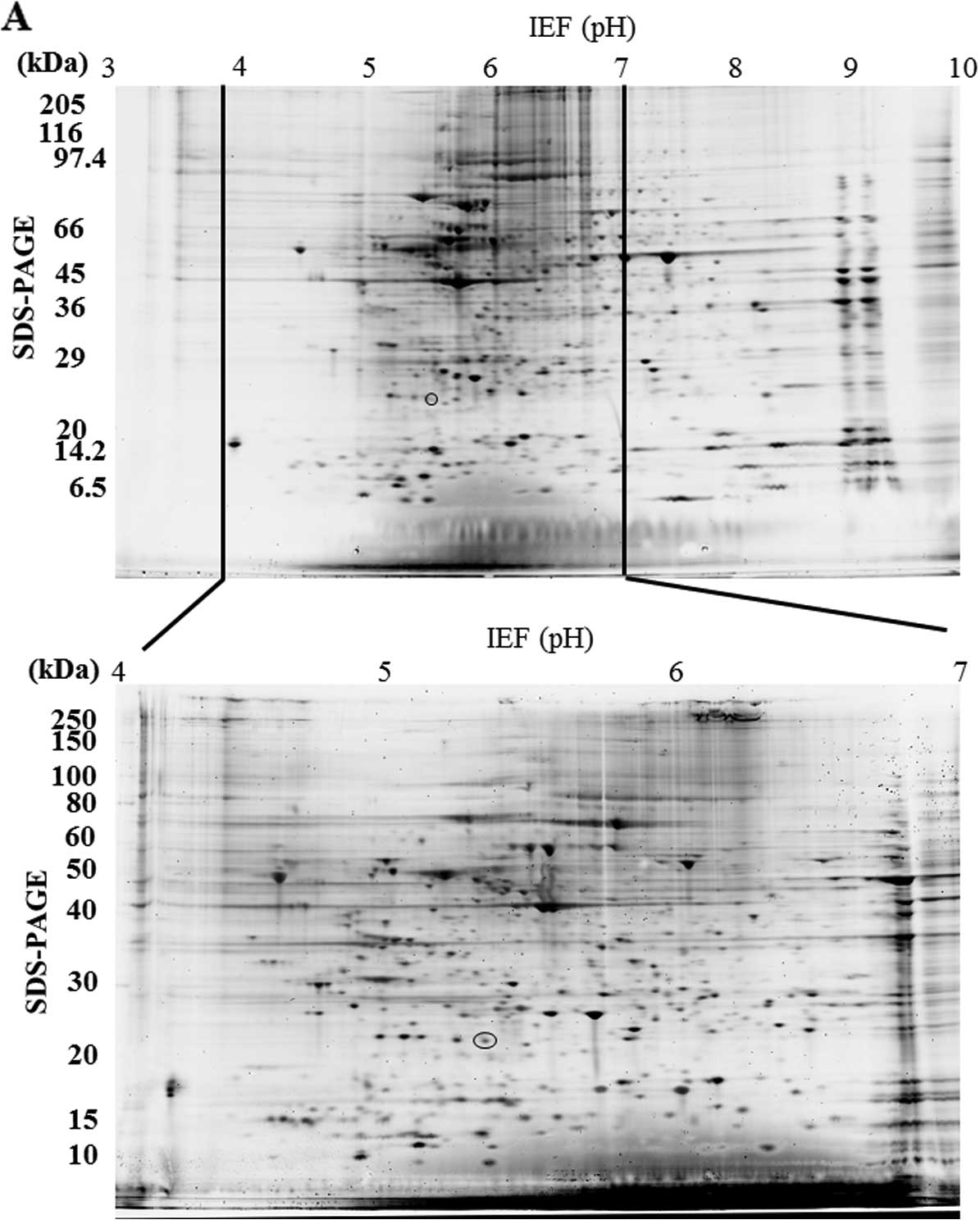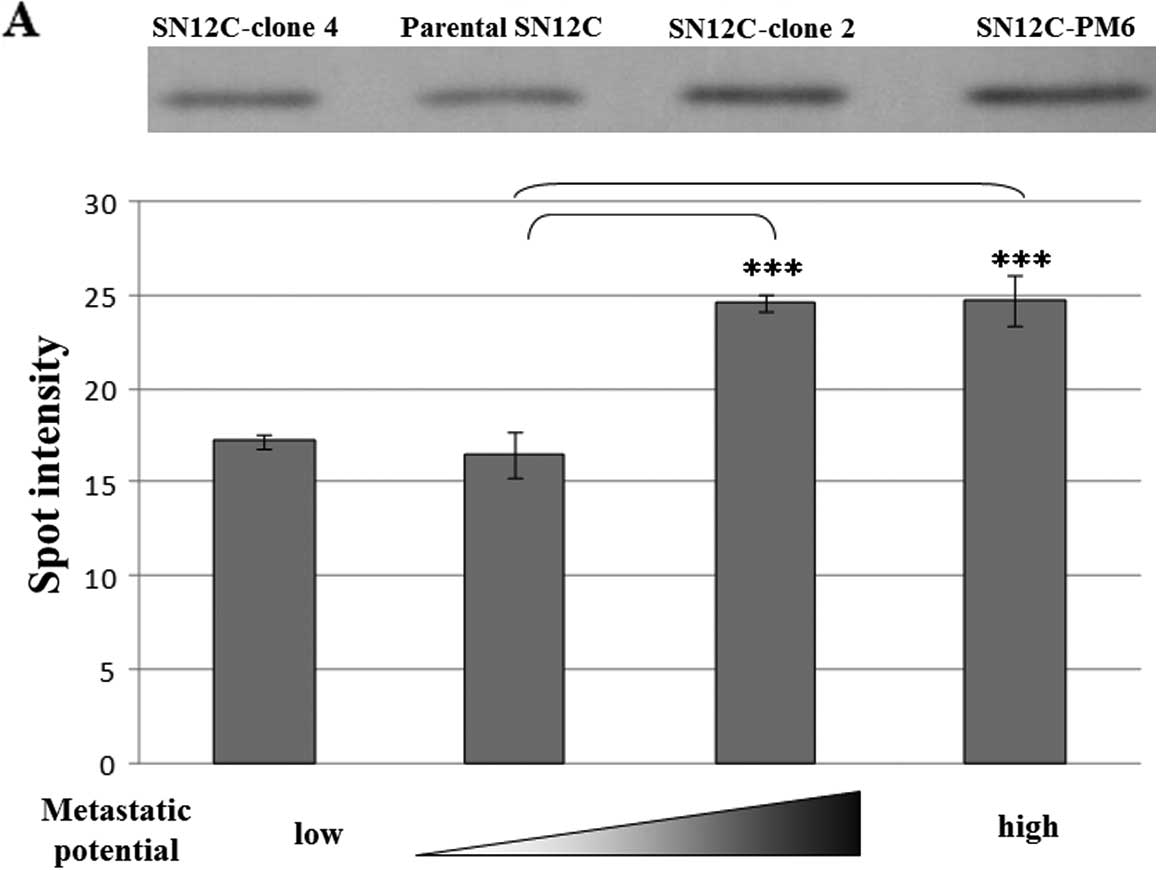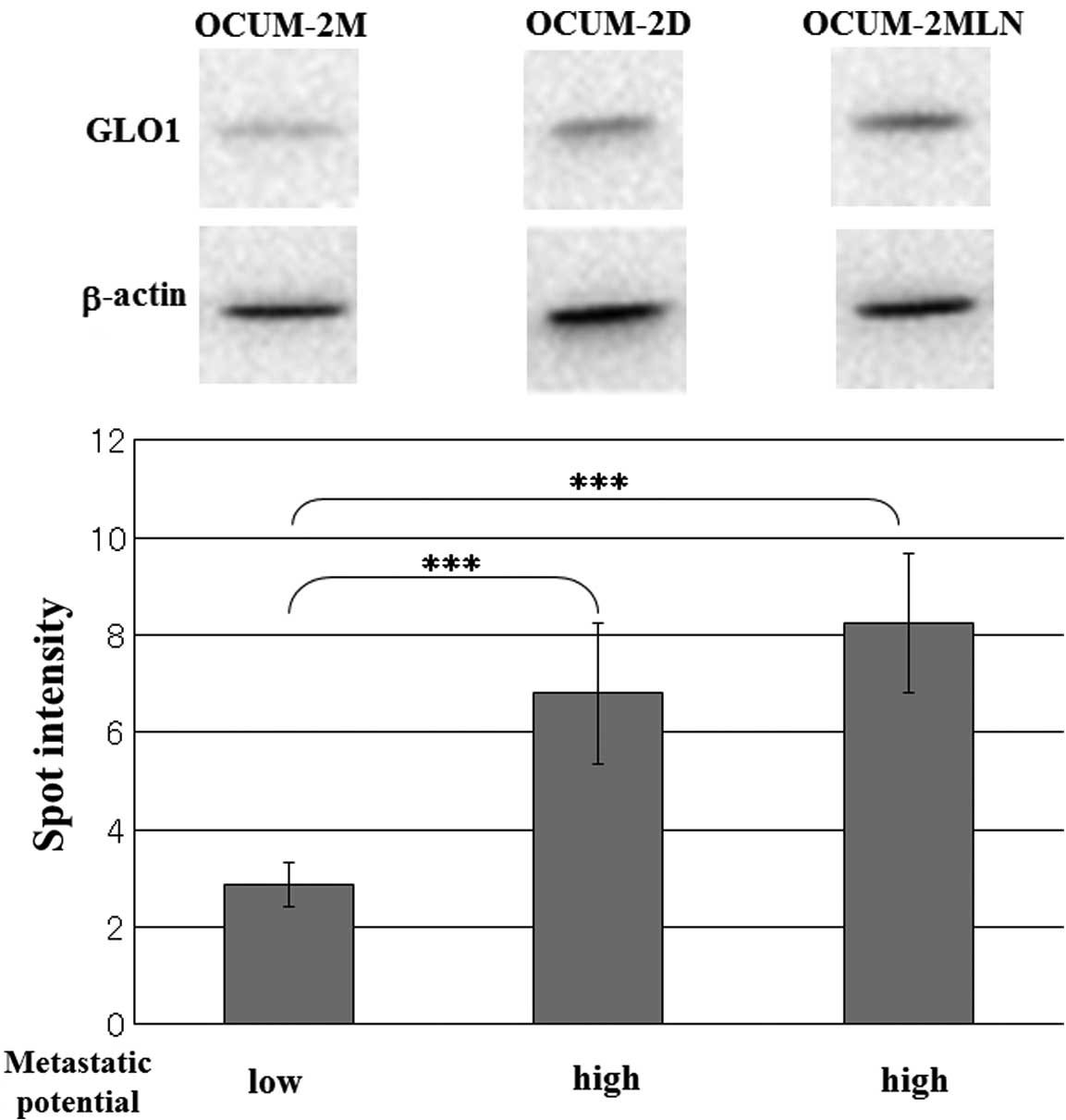|
1
|
Geiger TR and Peeper DS: Metastasis
mechanisms. Biochim Biophys Acta. 1796:293–308. 2009.PubMed/NCBI
|
|
2
|
Fidler IJ: Models for spontaneous
metastasis. Cancer Res. 66:97872006. View Article : Google Scholar : PubMed/NCBI
|
|
3
|
Naito S, von Eschenbach AC, Giavazzi R and
Fidler IJ: Growth and metastasis of tumor cells isolated from a
human renal cell carcinoma implanted into different organs of nude
mice. Cancer Res. 46:4109–4115. 1986.PubMed/NCBI
|
|
4
|
Naito S, Walker SM, von Eschenbach AC and
Fidler IJ: Evidence for metastatic heterogeneity of human renal
cell carcinoma. Anticancer Res. 8:1163–1167. 1988.PubMed/NCBI
|
|
5
|
Naito S, Walker SM and Fidler IJ: In vivo
selection of human renal cell carcinoma cells with high metastatic
potential in nude mice. Clin Exp Metastasis. 7:381–389. 1989.
View Article : Google Scholar : PubMed/NCBI
|
|
6
|
Tanaka T, Kuramitsu Y, Fujimoto M, Naito
S, Oka M and Nakamura K: Downregulation of two isoforms of
ubiquitin carboxyl-terminal hydrolase isozyme L1 correlates with
high metastatic potentials of human SN12C renal cell carcinoma cell
clones. Electolophoresis. 29:2651–2659. 2008. View Article : Google Scholar : PubMed/NCBI
|
|
7
|
Fidler IJ and Kripke ML: Metastasis
results from preexisting variant cells within a malignant tumor.
Science. 197:893–895. 1977. View Article : Google Scholar : PubMed/NCBI
|
|
8
|
Yashiro M, Chung YS, Nishimura S, Inoue T
and Sowa M: Peritoneal metastatic model for human scirrhous gastric
carcinoma in nude mice. Clin Exp Metastasis. 14:43–54. 1996.
View Article : Google Scholar : PubMed/NCBI
|
|
9
|
Fujihara T, Sawada T, Hirakawa K, Chung
YS, Yashiro M, Inoue T and Sowa M: Establishment of lymph node
metastatic model for human gastric cancer in nude mice and analysis
of factors associated with metastasis. Clin Exp Metastasis.
16:389–398. 1998. View Article : Google Scholar : PubMed/NCBI
|
|
10
|
Fukagawa Y, Nishikawa J, Kuramitsu Y,
Iwakiri D, Takada K, Imai S, Satake M, et al: Epstein-Barr virus
upregulates phosphorylated heat shock protein 27 kDa in carcinoma
cells using the phosphoinositide 3-kinase/Akt pathway.
Electrophoresis. 29:3192–3200. 2008.PubMed/NCBI
|
|
11
|
Mori-Iwamoto S, Kuramitsu Y, Ryozawa S,
Taba K, Fujimoto M, Okita K, Nakamura K and Sakaida I: A proteomic
profiling of gemcitabine resistance in pancreatic cancer cell
lines. Mol Med Rep. 1:429–434. 2008.PubMed/NCBI
|
|
12
|
Mori-Iwamoto S, Kuramitsu Y, Ryozawa S,
Mikuria K, Fujimoto M, Maehara S, Maehara Y, et al: Proteomics
finding heat shock protein 27 as a biomarker for resistance of
pancreatic cancer cells to gemcitabine. Int J Oncol. 31:1345–1350.
2007.PubMed/NCBI
|
|
13
|
Hayashi E, Kuramitsu Y, Okada F, Fujimoto
M, Zhang X, Kobayashi M, Iizuka N, et al: Proteomic profiling for
cancer progression: differential display analysis for the
expression of intracellular proteins between regressive and
progressive cancer cell lines. Proteomics. 5:1024–1032. 2005.
View Article : Google Scholar
|
|
14
|
Kuramitsu Y, Miyamoto H, Tanaka T, Zhang
X, Fujimoto M, Ueda K, Tanaka T, et al: Proteomic differential
display analysis identified upregulated astrocytic phosphoprotein
PEA-15 in human malignant pleural methothelioma cell lines.
Proteomics. 9:5078–5089. 2009. View Article : Google Scholar
|
|
15
|
Tamesa M, Kuramitsu Y, Fujimoto M, Maeda
N, Nagashima Y, Tanaka T, Yamamoto S, et al: Detection of
autoantibodies against cyclophilin A and triosephosphate isomerase
in sera from breast cancer patients by proteomic analysis.
Electrophoresis. 30:2168–2181. 2009. View Article : Google Scholar : PubMed/NCBI
|
|
16
|
Takashima M, Kuramitsu Y, Yokoyama Y,
Iizuka N, Harada T, Fujimoto M, Sakaida I, et al: Proteomic
analysis of autoantibodies in patients with hepatocellular
carcinoma. Proteomics. 6:3894–3900. 2006. View Article : Google Scholar : PubMed/NCBI
|
|
17
|
Takashima M, Kuramitsu Y, Yokoyama Y,
Iizuka N, Fujimoto M, Nishisaka T, Okita K, Oka M and Nakamura K:
Overexpression of alpha enolase in hepatitis C virus-related
hepatocellular carcinoma: association with tumor progression as
determined by proteomic analysis. Proteomics. 5:1686–1692. 2005.
View Article : Google Scholar
|
|
18
|
Ding Q, Wu Z, Guo Y, Zhao C, Jia Y, Kong
F, Chen B, et al: Proteome analysis of up-regulated proteins in the
rat spinal cord induced by transection injury. Proteomics.
6:505–518. 2006. View Article : Google Scholar : PubMed/NCBI
|
|
19
|
Henschke P, Vorum H, Honoré B and Rice GE:
Protein profiling the effects of in vitro hyperoxic exposure on
fetal rabbit lung. Proteomics. 6:1957–1962. 2006. View Article : Google Scholar : PubMed/NCBI
|
|
20
|
Shinohara M, Thornalley PJ, Giardino I,
Beisswenger P, Thorpe SR, Onorato J and Brownlee M: Overexpression
of glyoxalase-I in bovine endothelial cells inhibits intracellular
advanced glycation endproduct formation and prevents
hyperglycemia-induced increases in macromolecular endocytosis. J
Clin Invest. 101:1142–1147. 1998. View Article : Google Scholar
|
|
21
|
Thornalley PJ: Glyoxalase I - structure,
function and a critical role in the enzymatic defence against
glycation. Biochem Soc Trans. 31:1343–1348. 2003. View Article : Google Scholar : PubMed/NCBI
|
|
22
|
Mitsumoto A, Kim KR, Oshima G, Kunimoto M,
Okawa K, Iwamatsu A and Nakagawa Y: Glyoxalase I is a novel nitric
oxide responsive protein. Biochem J. 3:837–844. 1999. View Article : Google Scholar : PubMed/NCBI
|
|
23
|
de Hemptinne V, Rondas D, Vandekerckhove J
and Vancompernolle K: Tumour necrosis factor induces
phosphorylation primarily of the nitric-oxide-responsive form of
glyoxalase I. Biochem J. 407:121–128. 2007.PubMed/NCBI
|
|
24
|
de Hemptinne V, Rondas D, Toepoel M and
Vancompernolle K: Phosphorylation on Thr-106 and NO-modification of
glyoxalase I suppress the TNF-induced transcriptional activity of
NF-kappaB. Mol Cell Biochem. 325:169–178. 2009.PubMed/NCBI
|
|
25
|
Van Herreweghe F, Mao J, Chaplen FW,
Grooten J, Gevaert K, Vandekerckhove J and Vancompernolle K: Tumor
necrosis factor-induced modulation of glyoxalase I activities
through phosphorylation by PKA results in cell death and is
accompanied by the formation of a specific methylglyoxal-derived
AGE. Proc Natl Acad Sci USA. 99:949–954. 2002.
|
|
26
|
Cheng WL, Tsai MM, Tsai CY, Huang YH, Chen
CY, Chi HC, et al: Glyoxalase-I is a novel prognosis factor
associated with gastric cancer progression. PLoS One. 7:e343522012.
View Article : Google Scholar : PubMed/NCBI
|
|
27
|
Wang Y, Kuramitsu Y, Ueno T, Suzuki N,
Yoshino S, Izuka N, Akada J, et al: Glyoxalase I (GLO1) is
up-regulated in pancreatic cancerous tissues compared with related
non-cancerous tissues. Anticancer Res. 32:3219–3222.
2012.PubMed/NCBI
|
|
28
|
Fonseca-Sánchez MA, Rodríguez Cuevas S,
Mendoza-Hernández G, Bautista-Piña V, Arechaga Ocampo E, Hidalgo
Miranda A, Quintanar Jurado V, et al: Breast cancer proteomics
reveals a positive correlation between glyoxalase 1 expression and
high tumor grade. Int J Oncol. 41:670–680. 2012.PubMed/NCBI
|
|
29
|
Jones MB, Krutzsch H, Shu H, Zhao Y,
Liotta LA, Kohn EC and Petricoin EF III: Proteomic analysis and
identification of new biomarkers and therapeutic targets for
invasive ovarian cancer. Proteomics. 2:76–84. 2002. View Article : Google Scholar : PubMed/NCBI
|
|
30
|
Santel T, Pflug G, Hemdan NY, Schäfer A,
Hollenbach M, Buchold M, Hintersdorf A, et al: Curcumin inhibits
glyoxalase 1: a possible link to its anti-inflammatory and
anti-tumor activity. PLoS One. 3:e35082008. View Article : Google Scholar : PubMed/NCBI
|
|
31
|
Tsuruo T, Naito M, Tomida A, Fujita N,
Mashima T, Sakamoto H and Haga N: Molecular targeting therapy of
cancer: drug resistance, apoptosis and survival signal. Cancer Sci.
94:15–21. 2003. View Article : Google Scholar : PubMed/NCBI
|
|
32
|
Kawatani M, Okumura H, Honda K, Kanoh N,
Muroi M, Dohmae N, Takami M, et al: The identification of an
osteoclastogenesis inhibitor through the inhibition of glyoxalase
I. Proc Natl Acad Sci USA. 105:11691–11696. 2008. View Article : Google Scholar : PubMed/NCBI
|
|
33
|
Imoto M: Isolation of novel GGPP
synthase-inhibitor Gerfelin and evaluation of its activity. Bunshi,
Chobunshi, Chokozotai Rikogaku Heisei 15 Nendo Kenkyu Seika
Hokokusho Gakujutsu Furonthia. 597–656. 2004.(In Japanese).
|

















